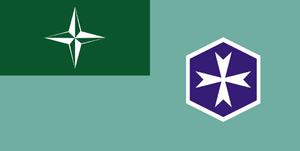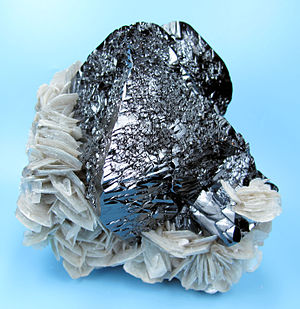Porfíria
| Axerka Porfíria Colony of Porfíria | |
 Flag | |
| Country | Kiravian Federacy |
| Capital | Vittēmur |
| Population | 6,586,000 |
| Governor | Rurovid H.H.M. Valerian |
| President | Adhrun Lavranmaxur |
| Stanora seats | 3 |
| Official languages | Kiravic |
| Other Languages | Maīoki, Ĥeldican Coscivian |
| Postal Abbreviation | PRF |
Porfíria is a colony of the Kiravian Federacy located on the southern extreme of the Cusinaut subcontinent in northeastern Crona. The territory extends from the mainland coast opposite the island of Rovaīon into the Archangel River Valley. Porfíria was first settled by Kiravians in YEAR, when the settlement of Vittēmur was established at the mouth of the Archangel River. Since then, it has attracted many thousands of Kiravian colonists who have built a local economy based on exploitation of the territory's rich fish stocks and reserves of minerals and timber.
History
The prehistory of northern Crona remains largely unknown, as both archæological and indigenous folklore studies are still in their initial stages. It is currently presumed that the ancestors of the Maïoki people were the first humans to settle in the area, leading a lifestyle of low-intensity slash-and-burn agriculture supplemented by hunting and fishing.
Colonial Porfíria's history begins in Template:H:title when the Kiravian navigator Xaridur Ithorian formally took possession of the island of Rovaīon for the Confederate Republics of Kiravia and established the settlement of Dun Érskin ("Fort Érskin"). [Blah blah early history of Rovaīon here]
Rovaīon became a base for mercantile and missionary excursions to the mainland of Cusinaut, many of which made use of the nearby Archangel River. Inan Macféden sailed up the river and explored/conquered the interior.
Until [Year below], Kiravia's possessions in Cusinaut formed a single District of Porfíria, which was subdivided into the Rovaīon Department (covering Rovaīon), the Archangel Department (encompassing the lower Archangel watershed), the Southern Department (encompassing coastal settlements to the south and west of the Archangel Department), the Northeastern Department, and the Interior Department. This territory had become so vast that it was increasingly difficult for the colonial government to manage as a single unit, and the disparities in settler population density and development between Rovaīon and the mainland territories was becoming a point of contention for Rovaīan colonists who tired of being governed as a frontier territory and sought to become a constituent state of the Confederate Republics.
In [Year], the Confederal Stanora passed an act separating Rovaīon from the mainland as a separate colony, and later granted it a colonial charter to allow its admission to the Confederacy as an overseas state. In [several years later], the Stanora separated the Southern Department to form the colony of Avenica, and in [several more years later] it partitioned the District of Porfíria out of existence, transforming its central regions along the lower Archangel into the Territory of Porfíria while the remaining inland areas were divided among several different intendancies and military districts.
Geography
Most of Porfíria has an oceanic climate.

Major Settlements:
- Krivôrok (County Benderyn) - 101,240
- Inverporfír (County Archangel) - 86,615
- Saar-Macféden (County Macféden) - 60,850
- Vittēmur (County Archangel) - 22,386
- Sudhrun (County Louth) - 16,780
- Nív-Inoksensus (Northern County) - 3,594
- Krummavísur (Northern County) - 1,816
- Fort Èulet (Northern County) - 857
- Michael-Vicksburg (Unorganised County) -720
Economy



Although not as highly developed as its offshore neighbour Rovaīon, Porfíria has a growing and diversifying economy based on a strong primary sector - including agriculture, mining, and the harvesting of timber and fish - and supplemented by transportation, resource processing, and service industries.
The climate and terrain of Porfíria are quite similar to that of Great Kirav, and colonists have had great success cultivating Kiravian staple crops such as potato, cale, barley, and oats. Crops native to Cusinaut, such as sallaw and clubfruit, are also cultivated, both by the indigenous population and on settler-owned land. Livestock raising is an important activity, focused on sheep and guanacos introduced from Great Kirav. As a result of the distributist land tenure policies adopted during colonisation and their continuation in the colony's own property laws, most settler-held agricultural land is family-owned and organised into parcels ranging from medium-sized estates to small, single-family homesteads. Most native-held agricultural land is owned collectively, either by tribes and clans according to traditional customary law or by the governments of the autonomous Maīokidan territories. Forestry is also an important industry, and Porfíria is a rising producer of softwood timber, pine resins, and paper products.
Rich stocks of [types of fish] and shellfish such as [species] are found in the cold waters of the Northern Approaches and the wider North Levantine Ocean, and [species] is plentiful in the relatively unpolluted Archangel River.
Tourism is hoped to become a major source of income for the colony in the future, as Porfíria's breathtaking natural scenery, agreeable (for Kiravians) climate, and many opportunities for hunting and fishing promise to make it a prime destination for the popular Kiravian activities of skiīng and backlanding.
Politics and Governance
As a chartered territory, Porfíria is an integral part of the Kiravian Federacy for the purpose of constitutional law, and enjoys a level of self-governance more limited than that of a full state but greater than that of a dependency or federal district.
The highest executive authority in the territorial government is the Executive Council, which is chaired by the Governor and comprises 10-15 additional members. Most members of the Executive Council are appointed by the Governor, but two are elected by the citizenry, another two are elected by the Legislative Conference, and one is chosen from among the indigenous leaders of the territory. The Governor himself is appointed by the Prime Executive of the Kiravian Federacy. The Executive Council directs the colony's bureaucratic apparatus and government agencies, managing them on a day-to-day basis as well as charting short- and medium-term policy directions. Executive decisions are usually made collectively, but certain powers, such as commanding the territorial militia and declaring states of emergency, are exercised unilaterally by the Governor, and the Governor's signature is required to validate all executive orders originating from the Council.
The territorial legislature, the Legislative Conference, comprises 50 members elected by single transferable vote. It is non-partisan, as political parties are banned by Porfíria's territorial charter. The Legislative Conference has the power to pass statutes, levy territorial taxes, elect two members of the Executive Council, confirm judicial appointments made by the Governor, and rule on certain matters concerning real property by means of private bills.
Historically, Delegates elected to represent Porfíria in the Federal Stanora sat with that body's various agrarian, distributist, and pro-colonial factions. The Porfírian populace was overwhelmingly opposed to Kirosocialism, and voted strongly in support of the National Renewal Movement in 21166. In the post-Kirosocialist era, Porfírian Delegates have typically sat with the neoconservative wing of the Shaftonist-Republican Alliance cadre, or with the Coscivian National Congress, reflecting the vital importance of national defence issues to this frontier colony.
| Member | Party | First Elected | |
|---|---|---|---|
| Svíridur Vidhedran | Independent (CNC) | 21206 | |
| Angus MacKeldin | Independent (SRA) | 21206 | |
Demographics
The majority of the territory's population is made up of indigenous Cronites. Most Cronites living within the boundaries of Porfíria belong to the Maïoki cultural and linguistic cluster dominant across northern Crona, the exceptions being three Tyohuxul-speaking tribes on the territory's southern frontier and one tribe on Irasúcróva island of undetermined linguistic affinity. To date, twenty separate Cronite tribes have been identified and contacted in Porfíria.
No census has yet been conducted in the territory, but government estimates place the number of colonists in the territory around half a million. Ethnically, Ĥeldican Coscivians and Kiravian Celts comprise a plurality of the population, many of them coming from the rugged maritime and mountain regions of northern Great Kirav, the Talavéiscan colonies, and Cèuvara. Deep South Coscivians from the Sydona Islands also have a major presence in the colony, as do Northern Coscivian groups (particularly the Ískem), Lúnstem, Sëoran Coscivians, Kaskem, and Saskem. Fishermen put out of work by the 21205 oil spill in the Strait of Canucróva and small farmers from Northwestern Great Kirav make up a large share of Porfíria's settler population.
Small numbers of Woolzi Arabs are known to live in the territory.
Religion
Porfírians follow a number of different religions, the largest of which are the Insular Apostolic Church and the Levantine Catholic Church. Porfíria has been a hotspot of Catholic missionary activity, with the Diocese of Destransar recording 10,000 baptisms of native Cronites in 21206.
Læstorianism is the third-largest religion in the colony, practised mostly among Northern Coscivians and Lúnstem. Islam is also present in the colony, and while there are only two registered Islamic congregations in the territory (one Sunni and another Shi'a, both located in Érscinsar), the actual practice of Islam is likely larger than this would suggest, especially since UIF troops have been stationed in the colony.
A small community of Apostolic monks lives near the northern extremity of Rovaīon, where they are involved with education and evangelisation activities in two neighbouring Maïoki villages. Template:Ixnay